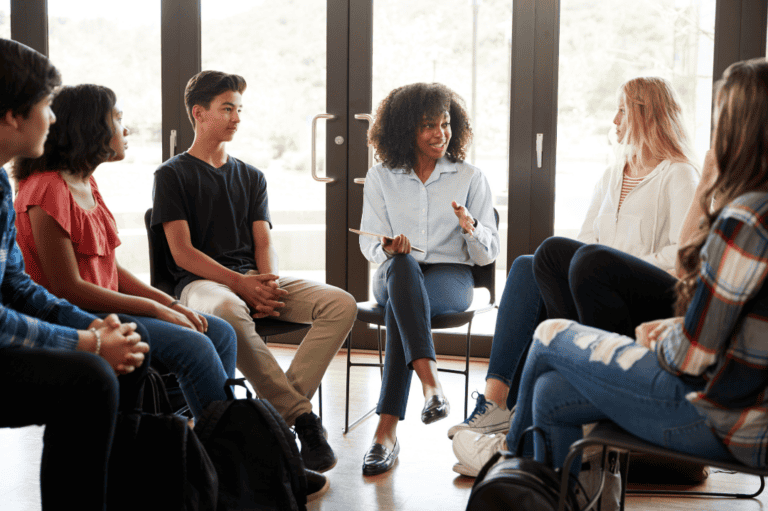Expert Interview: Caitlin Dunne
Caitlin Dunne is a high school English teacher at Blair Academy (NJ). She is currently getting her Doctorate in Education from the University of Bath. Her thesis, “Gender and Interaction in English Medium Instruction Class Discussions at a Turkish Secondary School” explores gender dynamics in classroom discussions. What follows is a conversation between Caitlin and R.E.A.L.® Director of Program Emily Gromoll. This conversation has been lightly edited for clarity.
Emily: I’m so excited to get to talk to you today! Tell me a little bit about your professional journey and how discussion became a topic of interest for you.

Caitlin: Before I began working at Blair Academy, I taught first at a school in the South Bronx for 11 years. The school I worked at pulled from the surrounding neighborhoods and had a 98% poverty rate. We considered it a victory just to get kids through the door. But, for me, the one thing I always enjoyed in English classes was discussion in general. So I did a lot of completely unstructured discussion in ways that worked for my kids in the South Bronx. That kind of conversational approach to literature really helped them, and my philosophy was that if I’m doing my job, I’m teaching beyond what the Regents exam expects. So I had a really good rapport with them and by the time they got to taking the Regents exam, they were scoring in the top 30%.
Then I taught abroad in Istanbul, Turkey for ten years. While I was in Istanbul, a colleague introduced me to Harkness. It was interesting because none of the kids I was teaching were native English speakers, so the students were always self-conscious about their English proficiency and how they sounded in the discussion.
When I first got to Blair and was introduced to R.E.A.L., I was instantly interested in it because of the use of nonverbal gestures and how scaffolded it is. I felt it would have been so helpful in Istanbul, and would have really supported those students who might feel self conscious about speaking.
When I first got to Blair and was introduced to R.E.A.L., I was instantly interested in it because of the use of nonverbal gestures and how scaffolded it is. I felt it would have been so helpful in Istanbul, and would have really supported those students who might feel self conscious about speaking.
Caitlin Dunne
Emily: The first time you tried a Harkness-style discussion, what were you excited about and what were you nervous about?
Caitlin: I liked that it provided a structure and that students had to prepare ahead of time with their own questions and things like that. Discussion prior to that was kind of “off the cuff”. But giving them that prep time to think ahead of time was really helpful. The population in Istanbul was completely different from the population in the South Bronx, and I went from one of the most underprivileged student populations to a very privileged student population, so different things worked differently. But there were also a lot of commonalities.
Emily: What sparked your interest in studying this further? What made you decide that you wanted to incorporate discussion as part of your graduate school research?
Caitlin: The school where I taught in Istanbul was an English Medium School, meaning that students were not native English speakers, but they were taking their classes in English. In a class size of about 20 to 24, you’d have a few kids who were completely fluent, a few kids who had very little English proficiency, and then a large range in between. And I would be teaching them a standard ninth grade literature course.
Emily: What were your strategies to bridge those differences in English language proficiency?
Caitlin: It was important to build a community within the classroom where students felt comfortable enough to take risks. Many students were very risk averse because of the nature of it being a very exam-driven school environment. Students felt that if you made a small mistake your whole future has been decided for you in the direction you don’t want. It was very important to me for students to feel comfortable speaking up, and know that they had something important to say, even if they were not going to say it in perfect English.
Emily: From this experience, what challenge did you feel like you wanted to try and tackle? What is your specific research question?
Caitlin: I’m in the EdD program through the University of Bath in England, which is a really interesting program because you can design within your own areas of interest. My research title is “Gender and Interaction in English Medium Instruction Class Discussions at a Turkish Secondary School.” I started by recording class discussions for a core group of 10 or 12 students from their prep year all the way through junior and senior year. So I have five years’ worth of discussion that I’ve been transcribing.
Once I finish the transcriptions, I’m going to be looking at the linguistic choices that were made in the prep year versus in the upper levels, and the patterns in a humanities class with linguistic choices. I’m looking at how students are entering the discussion, what phrases they are using, and then to see if there are any patterns that are tied to gender. Turkey has very strict gender roles, but they’re learning an American style education in English. A lot of kids would say, “oh, I’m a completely different person in English than I am in Turkish.” There’s some data out there that talks about how girls start participating less once they hit puberty, and there’s a lot of discussion at the university level of how women in business courses or science courses aren’t speaking up as much. However, there is less research about what happens during those pivotal high school years. Is it because of the way the teachers are interacting with the students? Is it the way the students are interacting with the material?
Emily: How are you handling the teacher interactions too? Because it feels like that is a component of all of this.
Caitlin: Since they were doing Harkness-style discussions across the board, there was very limited teacher intervention in the discussions. But I’m looking at the linguistic choices the teachers made when they’re speaking to a female student versus a male student. I was also using Equity Maps and I have all of those webs as well, so I can look back and I can trace when each student interacted with other students and how many times.
Emily: When you arrived at Blair and started to try out R.E.A.L. Discussion with your students, what felt the same and what felt different?
Caitlin: I think the biggest difference is the nonverbal communication. Trying to set up a R.E.A.L. Discussion with my freshman the first time, it was chaos everywhere at first. I told them, “just trust me. We’re going to try this for 10 minutes.” Some of the boys have really gotten into it with the nonverbal communication, but the girls are still shy. Since I’m still tracking all my data with Equity Maps, each discussion I throw up all of the webs and the data for the kids to see at the end of every discussion. I have students look at what happened during the discussion and reflect together on what happened. I’ll point to a pattern and ask them, “what happened here? Why didn’t we pay attention to this person? He was totally waving.”
I have students look at what happened during the discussion and reflect together on what happened. I’ll point to a pattern and ask them, “what happened here?
Caitlin Dunne
Emily: What is their reaction to that?
Caitlin: They find it fascinating! I also took all of the skills from the workbooks, and I’ve programmed in my own rubric into the Equity Maps. I try to trace what they’re doing, especially the NVC’s when they do them. So I’ll say to a student, “you had five NVCs here, and you did this, and you did that.” The kids love that, too, and getting all those minute details leads to a great discussion about the discussion. I also had the kids do a R.E.A.L. Discussion when the parents came for Parents’ weekend, and the parents thought it was amazing.
Emily: That is all so neat to hear. Final question: where will you go with your discussion practice from here?
Caitlin: I haven’t actually given them a grade yet on any of their R.E.A.L. Discussions, so that’s one thing I’m trying to figure out. I did create a rubric, but I haven’t used it yet. I also want to see R.E.A.L. in science classes and see how it could work outside of the humanities class. It could be great for the sophomores taking biology since they’ve been doing R.E.A.L. in their English classes and already know the system.
Emily: Caitlin, thank you so much for sharing your story and details about your research with me! I wish you the best of luck on all of the transcribing, which I’m sure is going to be a tremendous amount of work!





